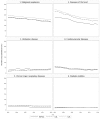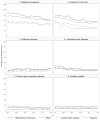Temporal Trends in Mortality Rates among Kaiser Permanente Southern California Health Plan Enrollees, 2001-2016
- PMID: 31050639
- PMCID: PMC6499114
- DOI: 10.7812/TPP/18-213
Temporal Trends in Mortality Rates among Kaiser Permanente Southern California Health Plan Enrollees, 2001-2016
Abstract
Background: Temporal analyses of death rates in the US have found a decreasing trend in all-cause and major cause-specific mortality rates.
Objectives: To determine mortality trends in Kaiser Permanente Southern California (KPSC), a large insured population, and whether they differ from those of California and the US.
Methods: Trends in age-adjusted all-cause and cause-specific mortality rates from 2001 to 2016 were determined using data collected in KPSC and those derived through linkage with California State death files and were compared with trends in the US and California. Trends of race/ethnicity-specific all-cause and cause-specific mortality rates were also examined. Average annual percent changes (AAPC) and 95% confidence intervals (CI) were calculated.
Results: From 2001 to 2016, the age-adjusted all-cause mortality rate per 100,000 person-years decreased significantly in KPSC (AAPC = -1.84, 95% CI = -2.95 to -0.71), California (AAPC = -1.60, 95% CI = -2.51 to -0.69) and the US (AAPC = -1.10, 95% CI = -1.78 to -0.42). Rates of 2 major causes of death, cancer and heart disease, also decreased significantly in the 3 populations. Differences in trends of age-adjusted all-cause mortality rates and the top 10 cause-specific mortality rates between KPSC and California or the US were not statistically significant at the 95% level. No significant difference was found in the trends of race/ethnicity-specific, sex-specific, or race/ethnicity- and sex-specific all-cause mortality rates between KPSC and California or the US.
Conclusion: Trends in age-adjusted mortality rates in this insured population were comparable to those of the US and California.
Conflict of interest statement
The author(s) have no conflicts of interest to disclose.
Figures



Similar articles
-
Temporal trends in heart failure mortality in an integrated healthcare delivery system, California, and the US, 2001-2017.BMC Cardiovasc Disord. 2021 May 26;21(1):261. doi: 10.1186/s12872-021-02075-6. BMC Cardiovasc Disord. 2021. PMID: 34039262 Free PMC article.
-
Sex-Specific Trends in Acute Myocardial Infarction Within an Integrated Healthcare Network, 2000 Through 2014.Circulation. 2020 Feb 18;141(7):509-519. doi: 10.1161/CIRCULATIONAHA.119.044738. Epub 2020 Feb 17. Circulation. 2020. PMID: 32065770
-
Comparative Trends in Heart Disease, Stroke, and All-Cause Mortality in the United States and a Large Integrated Healthcare Delivery System.Am J Med. 2018 Jul;131(7):829-836.e1. doi: 10.1016/j.amjmed.2018.02.014. Epub 2018 Apr 2. Am J Med. 2018. PMID: 29625083 Free PMC article.
-
Measuring integrated care.Dan Med Bull. 2011 Feb;58(2):B4245. Dan Med Bull. 2011. PMID: 21299927 Review.
-
Disease and injury in California with projections to the year 2007. Implications for medical education.West J Med. 1998 May;168(5):378-99. West J Med. 1998. PMID: 9614796 Free PMC article. Review.
Cited by
-
Trends in Influenza Vaccine Uptake and Severe Influenza-Related Outcomes at Kaiser Permanente Southern California, 2007-2017.Perm J. 2021 May;25:20.154. doi: 10.7812/TPP/20.154. Perm J. 2021. PMID: 33970069 Free PMC article.
-
Association of Glycated Hemoglobin Levels With Risk of Pancreatic Cancer.JAMA Netw Open. 2020 Jun 1;3(6):e204945. doi: 10.1001/jamanetworkopen.2020.4945. JAMA Netw Open. 2020. PMID: 32530471 Free PMC article.
-
Association between urban green space and postpartum depression, and the role of physical activity: a retrospective cohort study in Southern California.Lancet Reg Health Am. 2023 Mar 6;21:100462. doi: 10.1016/j.lana.2023.100462. eCollection 2023 May. Lancet Reg Health Am. 2023. PMID: 37223828 Free PMC article.
-
Prevalence and incidence of microvascular and macrovascular complications over 15 years among patients with incident type 2 diabetes.BMJ Open Diabetes Res Care. 2021 Jan;9(1):e001847. doi: 10.1136/bmjdrc-2020-001847. BMJ Open Diabetes Res Care. 2021. PMID: 33397671 Free PMC article.
-
Risk-enhancing factors and social determinants of health in risk assessment for atherosclerotic cardiovascular disease.PLoS One. 2024 Oct 25;19(10):e0312756. doi: 10.1371/journal.pone.0312756. eCollection 2024. PLoS One. 2024. PMID: 39453943 Free PMC article.
References
-
- ibm.com [Internet] IBM InfoSphere QualityStage. [cited 2018 January 1]. Available from: https://www.ibm.com/us-en/marketplace/infosphere-qualitystage/details.
-
- ibm.com [Internet] Probablistic Matching in IBM InfoSphere Master Data Management. [cited 2018 September 17]. Available from http://www-01.ibm.com/support/docview.wss?uid=swg27043172.
-
- ibm.com [Internet] What is the Soundex coding system. [cited 2018 January 1]. Available from: www-01.ibm.com/support/docview.wss?uid=swg21087113.
-
- Fellegi IP, Sunter AB. A theory for record linkage. Journal of the American Statistical Association. 1969;64(328):1183–210.
MeSH terms
LinkOut - more resources
Full Text Sources

